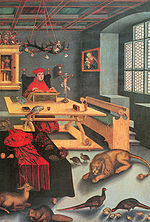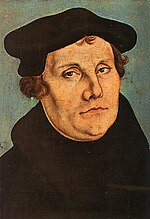Marktkirche Unser Lieben Frauen


The Marktkirche Unser Lieben Frauen ("Market Church of Our Dear Lady") is a church in the centre of the city of
The church replaced two former churches in the market area, their towers were integrated into the new building. The Market Church is considered one of the most important buildings of the late Gothic period in central Germany. Its four towers, together with the Red Tower, are the landmark of the city, hence its nickname "Stadt der fünf Türme" (City of the Five Towers).
History
The Market Church was built between 1529 and 1554 at the location of two predecessors, St. Gertrude and St. Mary. The Church of St. Gertrude to the west dated from 11th century and was the church of the salt makers in the center of Halle on the Hallmarkt, the salt market. The St. Mary's Church to the east dated from the 12th century and had been the parish church of the merchants and tradesmen of this mining town on the Marktplatz, the market square.

Cardinal
Construction history
From 1529 to 1530 the old nave of St. Gertrude was demolished. What remained were the Blue Towers dating from around 1400, with their spires, which had been added in 1507 and 1513. On the east side the Watchmen's Towers (Hausmanntürme) of St. Mary's, with Late Romanesque bases and Renaissance upper stories, dating from 1551 to 1554, were linked by a bridge for the watchmen, who in case of fire and danger alerted the inhabitants by the ringing of the bells. Today, the watchman's room (Hausmannsstube) can be viewed on certain occasions.

Lucas Cranach the Elder, 1529

The new church built between the two pairs of towers is the last great hall church of the
Subsequent history
The Market Church, which had been built to defend against the spread of
In 1625, during the
Handel and the Bach family


On 24 February 1685, Handel was baptized in the Market Church. The small organ above the altar, built between 1663 and 1664, a replacement for an earlier model and not replaced since, is one of the oldest in Central Germany; the young Handel received his first organ lessons from Friedrich Zachau, who was in service since 1684.[4]
In 1713,
Musicologists debate whether Bach's earliest extant Christmas cantata Christen, ätzet diesen Tag, BWV 63, with two choruses and two duets, but no arias or chorale, on text probably written by the Halle theologian J.M. Heineccius was premiered here in 1713 or in 1715,[8][9][10] or if it was performed for the bicentennial of the Reformation in 1717.[11]
From 1746 to 1764, his son
Pietism vs Early Enlightenment

In 1728, the 22-year-old
At the end of the 17th century, two important movements started in Halle which influenced many people during the 18th century:
On 12 July 1723,
What happened in Halle should not be seen as an isolated case, but as trendy and fashionable. Around 1720
In 1840 and 1841, the layout of the altar area was changed based on plans by Wilhelm August Stapel and Karl Friedrich Schinkel.[citation needed] The historical artist, Julius Hübner painted a new altarpiece of the Sermon on the Mount with the text Schaut die Lilien ("Consider the lilies" or "Look at the lilies").[19]
After World War II


The Market Church has not undergone any permanent changes to its external and internal appearance over its history. During the
Marian Library
The Market Church itself houses a library, the Marian Library (Marienbibliothek), which is considered to be one of the oldest and largest church libraries in Germany, founded in 1552 by Sebastian Boetius, senior pastor of the church. Until the establishment of the
Museum
In memory of the Reformation and Martin Luther, a small Luther Museum was established in the basement of the Blue Towers in May 2006. Amongst the objects on display are the death mask made of him on 19 February 1546 and impressions of his hands.[22]
References
- ^ Kowalski, J. "Die Sanierung der Hausmannstürme" (in German). Aki Halle. Archived from the original on April 6, 2012. Retrieved January 1, 2012.
- ^ "Die Beziehungen des Reformators Martin Luther zu Halle" (in German). Buergerstiftung Halle. Archived from the original on July 7, 2017. Retrieved January 1, 2012.
- ISBN 978-0-253-21180-4. Retrieved January 1, 2012.
- ISBN 978-0-8357-1833-2. Retrieved January 1, 2012.
- ^ Koster, Jan. "Weimar (II) 1708–1717". University of Groningen. Archived from the original on March 28, 2014. Retrieved January 1, 2012.
- ISBN 978-0-520-21414-9. Retrieved January 1, 2012.
- ^ "Gottfried Kirchhoff (Composer) – Short Biography". Bach-Cantantas. Retrieved January 1, 2012.
- ^ "Cantata BWV 63 Christen, ätzet diesen Tag Discussions – Part 1". Bach-Cantantas. Retrieved January 1, 2012.
- ^ "Johann Michael Heineccius (Librettist)". Back-Cantantas. Retrieved January 1, 2012.
- ^ Finscher, Ludwig (1976). Das Kantatenwerk. Harnoncourt and Leonhardt. p. 31.
- ^ John Eliot Gardiner (2010). "Cantatas for Christmas Day – Herderkirche, Weimar" (PDF). Bach-Cantatas. p. 1. Retrieved January 1, 2012.
- ^ "Über den Freundeskreis". Wfbach.de. Archived from the original on 2012-04-26. Retrieved 2012-01-02.
- ^ Baumgarten, Siegmund Jakob; Johann David Schleuen; Johann Salomo Semler (1757). Samlung von merkwürdigen Lebensbeschreibungen grösten Theils aus... Vol. 4. Retrieved January 1, 2012.
- ^ Wolf, C. (1985). Michael Albrecht (ed.). Oratio de Sinarum philosophia practica/Rede über die praktische Philosophie der Chinesen. Philosophische Bibliothek (in German). Hamburg, Germany: Felix Meiner Verlag. p. XXXIX.
- JSTOR 2707702.
- ^ "Auditorium Maximum der Universität Halle" (in German). Rathausseite. Archived from the original on February 11, 2013. Retrieved January 1, 2012.
- ISBN 978-0-7656-0661-7. Retrieved January 1, 2012.
- ISBN 978-0-19-925456-9.
- ^ "Hübner Rudolf Julius Benno" (in German). Sächsische Biografie. Retrieved January 1, 2012.
- ^ Kroll, Renate (1978). Schicksale deutscher Baudenkmale im zweiten Weltkrieg (in German). Vol. 2. Berlin: Henschelverlag. p. 385.
- ^ "Die Marienbibliothek in Halle" (in German). EKMD Online. Archived from the original on April 26, 2012. Retrieved January 1, 2012.
- ^ "Martin Luther's Death Mask on View at Museum in Halle, Germany". Art Daily. Retrieved 1 January 2012.
